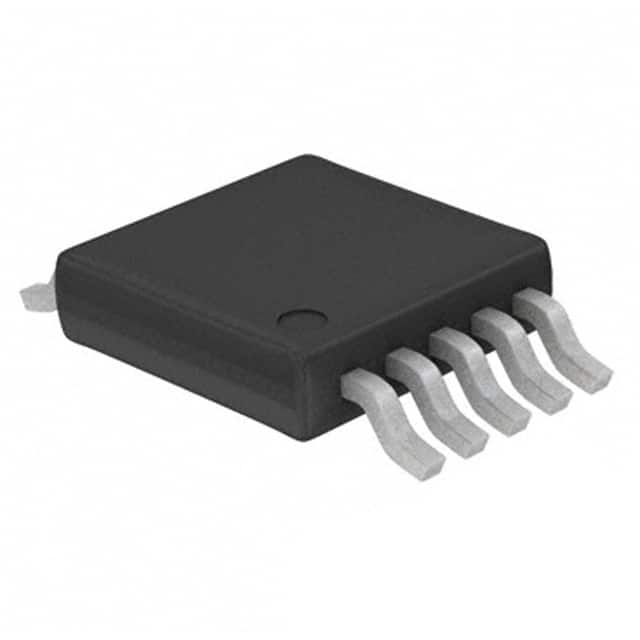MAX1486EUB+T
Product Overview
- Category: Integrated Circuit (IC)
- Use: RS-485/RS-422 Transceiver
- Characteristics: Low-power, half-duplex transceiver with enhanced ESD protection
- Package: 10-pin µMAX® package
- Essence: Provides reliable and robust communication in industrial environments
- Packaging/Quantity: Available in tape and reel packaging, quantity varies based on supplier
Specifications
- Supply Voltage Range: +3.0V to +5.5V
- Data Rate: Up to 250kbps
- Operating Temperature Range: -40°C to +85°C
- Number of Drivers/Receivers: 1 driver, 1 receiver
- ESD Protection: ±15kV Human Body Model (HBM), ±8kV IEC 61000-4-2 Air-Gap Discharge, ±6kV IEC 61000-4-2 Contact Discharge
Pin Configuration
The MAX1486EUB+T has the following pin configuration:
```
| | --| VCC GND |-- Pin 1: Power supply pins --| RO RE |-- Pin 2: Receiver output and receiver enable --| DI DE |-- Pin 3: Driver input and driver enable --| /RE A |-- Pin 4: Receiver enable and receiver input --| DE B |-- Pin 5: Driver enable and driver input --| Y Z |-- Pin 6: Driver output and receiver input --| B A |-- Pin 7: Receiver input and driver input --| Z Y |-- Pin 8: Receiver input and driver output --| GND VCC |-- Pin 9: Ground and power supply pins |___________| ```
Functional Features
- Low-power design for energy-efficient operation
- Enhanced ESD protection ensures reliability in harsh environments
- Half-duplex communication allows bidirectional data transfer
- Wide supply voltage range enables compatibility with various systems
- High data rate capability of up to 250kbps for fast and efficient communication
Advantages and Disadvantages
Advantages: - Robust communication in industrial environments - Enhanced ESD protection for improved reliability - Low-power design for energy efficiency - Wide supply voltage range for compatibility
Disadvantages: - Limited to half-duplex communication - Data rate may not be sufficient for high-speed applications
Working Principles
The MAX1486EUB+T is a half-duplex transceiver designed for RS-485/RS-422 communication. It operates by converting the differential signals from the driver input (DI) into balanced signals on the driver output (Y, Z). Similarly, it converts the balanced signals received on the receiver input (A, B) into differential signals on the receiver output (RO).
The driver enable (DE) and receiver enable (/RE) pins control the direction of data transmission. When DE is high and /RE is low, the device is in transmit mode, allowing data to be sent from DI to the driver output. Conversely, when DE is low and /RE is high, the device is in receive mode, enabling data reception from the receiver input to RO.
Detailed Application Field Plans
The MAX1486EUB+T is widely used in various industrial applications that require reliable and robust communication. Some common application fields include:
- Industrial Automation: Used in PLCs (Programmable Logic Controllers), SCADA (Supervisory Control and Data Acquisition) systems, and industrial control networks.
- Building Automation: Employed in HVAC (Heating, Ventilation, and Air Conditioning) systems, lighting control, and access control systems.
- Instrumentation: Utilized in data acquisition systems, test and measurement equipment, and sensor networks.
- Automotive: Integrated into automotive diagnostic tools, vehicle communication systems, and telematics devices.
- Renewable Energy: Applied in solar power monitoring systems, wind turbine control, and energy management systems.
Detailed and Complete Alternative Models
- MAX1487EUB+T: Similar to MAX1486EUB+T but with two drivers and one receiver.
- MAX1488EUB+T: Half-duplex transceiver with enhanced ESD protection and shutdown mode.
- MAX485EUB+T: Full-duplex RS-485/RS-422 transceiver with low-power operation.
- SN75176BDR: RS-485 transceiver with wide supply voltage range and thermal shutdown protection.
- LTC2854IGN#PBF: Low-power RS-485 transceiver with high data rate capability and fail-safe receiver.
These alternative models offer similar functionality and can be considered based on specific
Senaraikan 10 soalan dan jawapan biasa yang berkaitan dengan aplikasi MAX1486EUB+T dalam penyelesaian teknikal
Sure! Here are 10 common questions and answers related to the application of MAX1486EUB+T:
Q: What is the MAX1486EUB+T? A: The MAX1486EUB+T is a transceiver IC that converts TTL/CMOS logic levels to RS-485/RS-422 differential voltage signals.
Q: What is the purpose of using the MAX1486EUB+T in a technical solution? A: The MAX1486EUB+T is commonly used to enable long-distance communication between devices over RS-485 or RS-422 networks.
Q: Can the MAX1486EUB+T be used for both RS-485 and RS-422 applications? A: Yes, the MAX1486EUB+T can be used for both RS-485 and RS-422 applications as it supports both standards.
Q: What is the maximum data rate supported by the MAX1486EUB+T? A: The MAX1486EUB+T supports data rates up to 2.5 Mbps.
Q: Does the MAX1486EUB+T require external components for operation? A: Yes, the MAX1486EUB+T requires external resistors for termination and biasing.
Q: Can the MAX1486EUB+T operate with a single power supply? A: Yes, the MAX1486EUB+T can operate with a single power supply ranging from 4.75V to 5.25V.
Q: Is the MAX1486EUB+T compatible with 3.3V logic levels? A: No, the MAX1486EUB+T is designed for use with 5V logic levels.
Q: Can the MAX1486EUB+T be used in half-duplex communication systems? A: Yes, the MAX1486EUB+T supports both half-duplex and full-duplex communication modes.
Q: What is the operating temperature range of the MAX1486EUB+T? A: The MAX1486EUB+T can operate in the temperature range of -40°C to +85°C.
Q: Is the MAX1486EUB+T available in a surface-mount package? A: Yes, the MAX1486EUB+T is available in a 10-pin µMAX package for surface-mount applications.
Please note that these answers are general and may vary depending on the specific requirements and datasheet of the MAX1486EUB+T.


